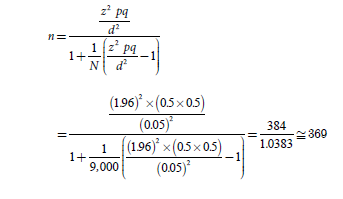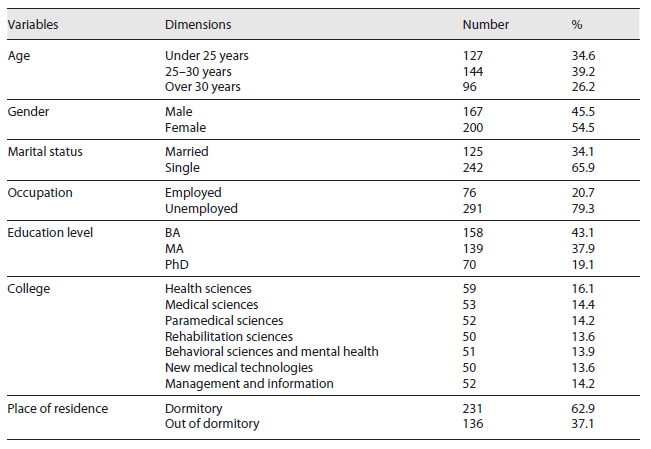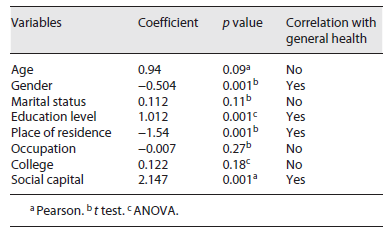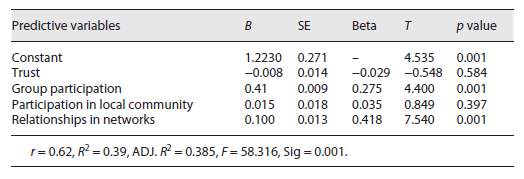Introduction
In recent decades, noncommunicable diseases, often known as chronic diseases, have emerged as the primary danger to global health and the leading cause of mortality throughout the globe 1. Currently, noncommunicable illnesses are responsible for more than 53% of the disease burden and 59% of the world’s total fatalities 2,3. However, by the year 2020, noncommunicable diseases will be the primary cause of 60% of the disease burden and 73% of all deaths 4. Statistics compiled by the United Nations indicate that more than 52 million individuals are struggling with their mental health. The most significant dangers to people’s health in Iran are behavioral and mental problems 5, and the country has a prevalence rate of 23.6% for mental disease on average 6.
Even though genetic and infectious factors play an important part in both health and the occurrence of diseases, attention is now being focused on the social background and context of diseases, and it has been found that health is more dependent on social factors than it is on medical interventions 7. Health, as defined by the World Health Organization, is not only the absence of sickness but rather the presence of full mental, bodily, and social well-being 8. Interventions that are both efficient and inexpensive are what modern social models of health are looking for in order to improve the overall health of people living in a society 9. In fact, it is impossible to provide an accurate picture of the state of health and disease in a society without taking into account the socioeconomic factors that play a role in the development of many diseases, both physical and mental, including the fact that many of these diseases are strongly associated with social factors 10,11.
The level of social capital in a community is recognized as one of the most influential on an individual’s health 12,13. An example of social capital is a collection of informal standards or values that are held in common by members of a group with whom collaboration is possible. The terms “trust,” “collaboration,” and “interrelationships” between members of a group are all examples of the kinds of notions that are included under the umbrella of social capital. The purpose of social capital is to guide a group toward objectives that are recognized by the larger community 14,15. This phenomenon is successful in enhancing access to social care, and its decline is related to sickness and bad health. To put it another way, if the public’s health is prioritized, then a significant portion of the focus should unavoidably be placed on social interactions and problems 16. The spread of health information, the possibility of more health-adapted norms and behaviors, social control of health-threatening behaviors, easier access to local facilities and services, and psychological processes like effective support can all affect a person’s overall health 17,18.
In the last several decades, a great number of studies have been conducted to explore social capital and the significance it has for college students 19-21. According to the findings of several studies 22,23, perceived stress 24, physical activities 25, mental health issues 26, and the academic performance of students, social capital has been shown to have a correlation with all of these variables 9,27. According to research conducted in Australia by Bye et al. 28, social capital helps students feel more satisfied with their university lives, which in turn may improve their academic performance. In addition, a study that was conducted on the students of Tabriz University of Medical Sciences in Iran revealed that social capital had a substantial association with the student’s perspectives on the use of tobacco products 29. In Iranian health studies, less attention has been paid to the importance of the effects of social variables on health, and the importance of many key determinants in this area, such as social capital, has still been neglected. In addition, the importance of the effects of social variables on health has received less attention. This study investigates the relationship between health and social capital among university students, who are one of the most important social groups in any country. Taking into account how important health is and the fact that social capital is one of its most important parts, this research looks into the relationship between health and social capital among university students.
Methods
Design and Participant
This was a cross-sectional, descriptive-analytical study. In 2018, all students at Iran University of Medical Sciences (N = 9,000) were included in the statistics population. The contestants’ minimum age was 18 years, while their maximum age was limitless. The list of all students was acquired after gaining ethical approval from the university. To ensure that everyone had an equal chance of being chosen, a simple random sampling approach was used to choose the samples. As a result, each student was assigned a code, the samples were chosen using a table of random numbers, and they were requested to collaborate in person. In circumstances where the questionnaire was incomplete or one individual refused to participate, another person was chosen at random. The capacity to answer questions, being a student at Iran University of Medical Sciences, and willingness to engage in the study were all inclusion requirements. The sample size was established using Cochran’s approach, which resulted in 369 people being selected as the sample size, of which 2 questionnaires were incomplete and 367 questionnaires were evaluated as research data.
Measures
Two standard surveys and demographic questions to gather data, Delaviz (2006) 30 Social Capital Questionnaires (2006) and Goldberg and Hiller (1979) 31 General Health Questionnaire were utilized. The Delaviz Social Capital Questionnaire features 27 items and four subscales of trust, group engagement, local community participation, and social network linkages. The scoring technique is based on a five-point Likert scale, with the scores of questions 18, 19, and 20 reversed, and the other questions scored at 4 for entirely agreed and 0 for completely disagreed, for a total score of 108. According to Delaviz 30, the reliability of this questionnaire based on Cronbach’s alpha is 0.85. In this research, the questionnaire was provided to 30 students before collecting the primary data, and after collecting it, a Cronbach’s alpha of 0.78 was found, which is a satisfactory number and indicates that the questionnaire has high internal reliability. The Goldberg and Hiller General Health Questionnaire comprises 28 questions and four subscales, each with seven items. Somatic symptoms, anxiety and sleeplessness, social dysfunction, and severe depression are all included in these measures. A low score on any subscale implies health, whereas a high score shows pain and the lack of health in a person. In this research, Cronbach’s alpha of 0.738 was used in this research to validate the reliability of the general health questionnaire 31.
Data Analysis
To convey the status of variables and characterize the findings, SPSS software (Version 22, SPSS Inc., Chicago, IL, USA) and descriptive statistics such as frequency, percentage, mean, and standard deviation were employed. The data were found to be normal using the Kolmogorov-Smirnov test at p > 0.05. To analyze the link between the hypotheses, analysis of variance, independent t test, and Pearson correlation coefficient were employed, and multiple linear regressions using the entry technique were used to assess the predictive ability of the social capital variable. A significance threshold of p < 0.05 was used in this investigation.
Ethical Considerations
In order to adhere to ethical issues, the code of ethics (IR.IUMS.REC.1395.95-04-153-28574) was received from the Iran University of Medical Sciences in the first step. Also, a written agreement was received from the participants throughout the research, and they participated in the study willingly. They were informed that their personal information would be kept secret, and they had the right to exit the study. After receiving instructions and being pleased with the research ethics, everyone who was asked to participate in the study completed the questionnaires.
Results
In this study, 367 people were included in the study. The mean age of the participants was 26 years, and most of them were in the age group of 25-30 years. 54.5% of participants were female, and 65.9% were single. Also, 79.3% of the respondents were unemployed (Table 1).
Table 2 shows the status of social capital and general health variables and their dimensions. Social capital in some dimensions (trust, group participation, and relationships in the social network) was reported as medium and low. In all the samples, trust was one of the examined dimensions at a low level, and its mean and standard deviation were 10.97 ± 2.14. In other dimensions, the percentage of people who reported average status was higher than the percentage of people who reported low status, but in none of the dimensions, high status (suitable) was reported. For general health status, the results showed that the social dysfunction dimension is worse compared to other dimensions, and 93.4% of the samples reported it as medium or high, while in the anxiety dimension, the mean, and standard deviation were 13.46 ± 3.36. Only 3% had high anxiety. Also, in terms of somatic symptoms and depression, 5.7% and 5.4% of people were in poor condition, respectively (Table 2).
There was a substantial link between gender and overall health, with males having a higher mean score of general health (13.85) than females (12.15). In other words, men had better overall health than women. There was a substantial difference in people’s general health based on their degree of education, with Ph.D. students having better overall health than other groups. There was a substantial association between the site of living and overall health, with nondormitory students having better general health (13.72) than dormitory students (12.30). That is, nondormitory students had better health than dormitory students. Social capital was also linked to general health, implying that people with more social capital had better overall health. There was, however, no statistically significant association between age, marital status, work status, or college attendance and overall health (Table 3).
Multivariate regression showed a relationship between the dimensions of social capital and students’ general health. Among the dimensions of social capital, two dimensions of group participation and relationships in networks have significant predictive power for the dependent variable, i.e., general health. These two variables together predict 39% of the variance in general health (Table 4).
Discussion
The purpose of this research was to look at the link between social capital and overall health among students at the Iran University of Medical Sciences. The findings revealed a substantial association between social capital and general health; i.e., increasing social capital improves people’s health, which is consistent with past studies on this topic 32-34. Gilbert et al. 35 discovered in a comprehensive review and meta-analysis research that building social capital increases people’s odds of health by 27%. Furthermore, social connections and trust (both aspects of social capital) boost the likelihood of excellent health by 39% and 32%, respectively. Although most research has focused on men and women, several studies have shown a link between social capital and mental health among students 24,36. Social capital is an important resource for individuals because it has a large impact on their ability to act and their quality of physical life. It also provides conditions for the individual to enjoy the social support of the group and the community, which comforts them and reduces their anxiety, ultimately leading to the person’s mental and general health. Through sentiments of trust, life expectancy, involvement, and the encouragement of collective action based on mutual trust and mutual empathy, social capital may even lessen the desire to engage in high-risk health behaviors 37-40.
Two measures of social capital in this study, group membership and ties in networks, showed a greater link with overall health, which is consistent with previous research 40-42. Gilbert et al. 35 have shown that social connections improve one’s chances of being healthy. Social networks help people play different roles and improve their health by instilling self-esteem and self-worth in them. Participation in the community and volunteer groups improves mental health by providing a feeling of identity, belonging, and self-worth. It is very important to improve these aspects of social capital through the right interventions and planning. The study’s findings revealed a link between gender and overall health, which was consistent with previous research 43‒45. Furthermore, males had better overall health than women, which was consistent with Yiengprugsawan et al.’s 2011 results showing women had lower levels of health 46‒48. This issue is caused by gender limitations in society 49 which may also be evident in the academic setting for female university students. Male students are not restricted from spending time outside the dormitories, but female students are. In addition, female students have fewer athletic and cultural opportunities than male students, which might have an impact on their health.
The findings revealed that the average general health of students varied depending on their degree of education, with Ph.D. students having the best overall health. Ghaderi et al. (2015) 50 discovered a substantial link between overall health (anxiety and depression) and students’ education. However, our findings contradicted those of Maghsoudi et al., 2015 51. This might be because doctoral students’ personalities have been shaped in some manner, and they have removed themselves from the dangerous activities of undergraduate and graduate students. They also feel more autonomous and confident as a result of the financial assistance provided by the institution, which may have an impact on their health. Finally, students with a higher educational level have greater access to health information and awareness to engage in healthy and preventative activities, which will benefit their health as well.
The findings indicated that there is a link between housing status and overall health, with nondormitory students having better health than dormitory students. Mazhariazad and Rozbe 52 found a substantial link between housing status and overall health, which is consistent with our results. However, the findings of Namazi et al. 53 contradicted our findings. Being in a dorm and away from home may have a variety of psychological repercussions on a person, including a lack of emotional support and supervision from family. A person’s health may also be harmed by poor food quality, inadequate dormitory amenities, and the presence of smoking housemates, among other things. In general, people think that living in a dorm, going through different situations with limited amenities, and not being able to control the environment and people around them could be bad for the health of the students.
However, there was no significant association between age, marital status, employment, or college and students’ overall health, which is similar to the findings of previous research 51,53. Other research, however, has shown outcomes that contradict ours. For example, Warren-Findlow et al. 41 show that mental health improves with age. However, Yiengprugsawan et al. 46 discovered that elderly people had worse overall health. Health decline with aging might be a normal occurrence. This is because as individuals age, their physical conditions deteriorate, and they may experience various physical and mental ailments, as well as serious issues due to a lack of social capital and assistance. Furthermore, in a study conducted by Yiengprugsawan et al. 46, single people had worse overall health than married people. The discrepancy between our findings and those of other studies may be attributed to the kind and amount of samples used, as well as the statistical population of students, while in other studies, people of a larger age range (women and men) were investigated.
The current study is one of the few that investigates the link between social capital and health among Iranian students and gives data to university administrators, which can be used to improve students’ social capital and overall health. The limitations of this study include the participants’ unwillingness to complete the questionnaires; conducting a cross-sectional study on only one university’s students and not investigating the causal relationships between variables; completing the questionnaires by self-report; and the possibility of bias in the given answers. More study is needed on the subjects of social capital and student health, as well as approaches to improve them using other research tools and methodologies, such as qualitative methods and educational interventions.
Conclusion
According to the findings, there is a substantial connection between social capital and overall health, and the results also demonstrated that the two aspects of social capital that have the biggest influence on overall healthcare group involvement and connections in networks. It is possible to improve students’ health as a whole if social capital is increased, more students are encouraged to work on group projects, and students spend more time talking to each other in their networks.
Acknowledgments
The authors would like to thank all participants for their cooperation in this study.
Statement of Ethics
Ethical approval was obtained from the Iran University of Medical Sciences (IR.IUMS.REC.1395.95-04-153-28574) and was obtained from the Iran University of Medical Sciences. Written consent was obtained from all participants.
Author Contributions
All authors participated and approved the study design. J.Y.L., S.F.I., and M.A.M.G. contributed to designing the study. A.A.D. and A.A. collected the data and analyzed it by M.M., A.Z., and M.A.M.G. The final report and article were written by S.F.I., J.Y.L., and A.A. All authors read and approved the final manuscript.



















